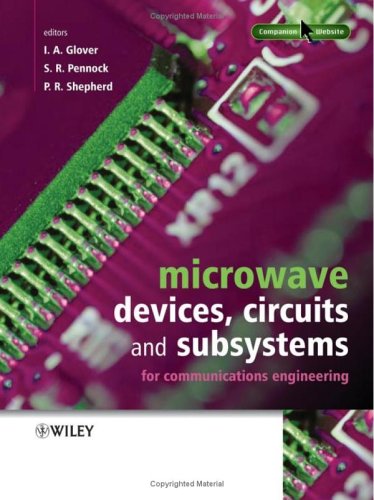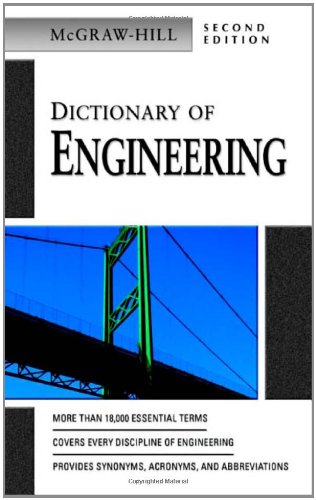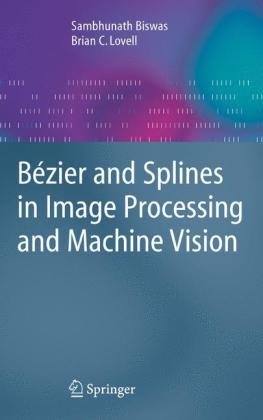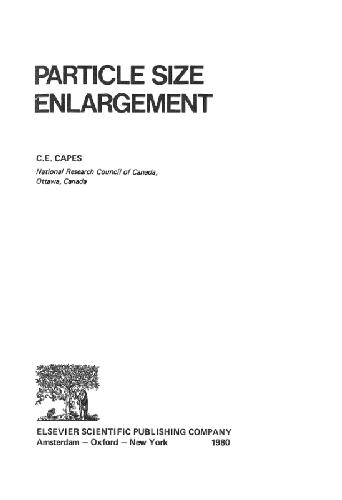Ian A. Glover, Steve Pennock, Peter Shepherd047189964X, 9780471899648, 9780470012741
Table of contents :
MICROWAVE DEVICES, CIRCUITS AND SUBSYSTEMS FOR COMMUNICATIONS ENGINEERING……Page 3
Contents……Page 7
List of Contributors……Page 17
Preface……Page 19
1.1 Introduction……Page 21
1.2 RF Devices……Page 22
1.3 Signal Transmission and Network Methods……Page 24
1.4 Amplifiers……Page 25
1.5 Mixers……Page 26
1.7 Oscillators and Frequency Synthesisers……Page 27
2.1 Introduction……Page 29
2.2.1 Intrinsic Semiconductors……Page 30
2.2.2.1 N-type doping……Page 33
2.2.3 Band Model for Semiconductors……Page 34
2.2.4 Carrier Continuity Equation……Page 37
2.3.1 Thermal Equilibrium……Page 38
2.3.2 Reverse Bias……Page 41
2.3.3 Forward Bias……Page 43
2.3.4 Diode Model……Page 44
2.3.5 Manufacturing……Page 45
2.3.6 Applications of P-N Diodes at Microwave Frequencies……Page 46
2.3.6.1 Amplitude modulators……Page 48
2.3.6.2 Phase shifters……Page 49
2.3.6.3 Frequency multipliers……Page 50
2.4.1 Thermal Equilibrium……Page 52
2.4.2 Reverse Bias……Page 54
2.4.3 Forward Bias……Page 55
2.4.4 Electric Model……Page 56
2.4.6 Applications……Page 57
2.4.6.1 Detectors……Page 58
2.4.6.2 Mixers……Page 59
2.5.2 Reverse Bias……Page 60
2.5.3 Forward Bias……Page 61
2.5.4 Equivalent Circuit……Page 63
2.5.5 Manufacturing……Page 64
2.5.6.1 Switching……Page 65
2.5.6.2 Phase shifting……Page 67
2.5.6.4 Power limiting……Page 70
2.6 Step-Recovery Diodes……Page 71
2.7 Gunn Diodes……Page 72
2.7.1 Self-Oscillations……Page 74
2.7.2 Operating Modes……Page 75
2.7.2.3 Quenched dipole layer mode……Page 76
2.7.3 Equivalent Circuit……Page 77
2.7.4.1 Negative resistance amplifiers……Page 78
2.8 IMPATT Diodes……Page 79
2.8.2 Principle of Operation……Page 80
2.8.3 Device Equations……Page 82
2.8.4 Equivalent Circuit……Page 83
2.9.1.2 Small and large signal behaviour……Page 85
2.9.2 GaAs MESFETs……Page 86
2.9.2.1 Current-voltage characteristics……Page 88
2.9.2.2 Capacitance-voltage characteristics……Page 90
2.9.2.3 Small signal equivalent circuit……Page 91
2.9.2.5 Curtice model……Page 94
2.9.3 HEMTs……Page 95
2.9.3.1 Current-voltage characteristics……Page 96
2.9.3.4 Large signal equivalent circuit……Page 98
2.9.4 HBTs……Page 100
2.9.4.2 Capacitance-voltage characteristics……Page 104
2.9.4.3 Small signal equivalent circuit……Page 106
2.9.4.4 Large signal equivalent circuit……Page 107
2.10 Problems……Page 108
References……Page 109
3.1 Introduction……Page 111
3.2.1 Structural Classification……Page 112
3.2.2 Mode Classes……Page 114
3.3 The Two-Conductor Transmission Line: Revision of Distributed Circuit Theory……Page 115
3.3.1 The Differential Equations and Wave Solutions……Page 116
3.3.2 Characteristic Impedance……Page 118
3.4 Loss, Dispersion, Phase and Group Velocity……Page 119
3.4.2 Loss……Page 120
3.4.3 Dispersion……Page 121
3.4.4 Group Velocity……Page 122
3.4.5 Frequency Dependence of Line Parameters……Page 125
3.4.5.1 Frequency dependence of G……Page 128
3.4.6 High Frequency Operation……Page 129
3.4.6.2 The telegrapher’s equation and the wave equation……Page 131
3.5 Field Theory Method for Ideal TEM Case……Page 133
3.5.1 Principles of Electromagnetism: Revision……Page 134
3.5.3 The Static Solutions……Page 137
3.5.4 Validity of the Time Varying Solution……Page 139
3.5.5 Features of the TEM Mode……Page 141
3.5.5.1 A useful relationship……Page 142
3.5.6 Picturing the Wave Physically……Page 143
3.6 Microstrip……Page 146
3.6.1.1 Fields and static TEM design parameters……Page 148
3.6.1.2 Design aims……Page 149
3.6.1.3 Calculation of microstrip physical width……Page 150
3.6.2 Dispersion and its Accommodation in Design Approaches……Page 152
3.6.3 Frequency Limitations: Surface Waves and Transverse Resonance……Page 155
3.6.4 Loss Mechanisms……Page 157
3.6.5.1 The foreshortened open end……Page 159
3.6.5.2 Microstrip vias……Page 161
3.6.5.4 The microstrip T-junction……Page 162
3.6.6.1 Microstrip low-pass filters……Page 165
3.7 Coupled Microstrip Lines……Page 168
3.7.1 Theory Using Even and Odd Modes……Page 170
3.7.1.1 Determination of coupled region physical length……Page 176
3.7.1.2 Frequency response of the coupled region……Page 177
3.7.1.3 Coupler directivity……Page 178
3.7.1.4 Coupler compensation by means of lumped capacitors……Page 179
3.7.2 Special Couplers: Lange Couplers, Hybrids and Branch-Line Directional Couplers……Page 181
3.8 Network Methods……Page 183
3.8.1 Revision of z, y, h and ABCD Matrices……Page 184
3.8.2 Definition of Scattering Parameters……Page 186
3.8.3 S-Parameters for One- and Two-Port Networks……Page 188
3.8.5 Conversion of S-Parameters into Z-Parameters……Page 191
3.8.6 Non-Equal Complex Source and Load Impedance……Page 194
3.9.1 The Smith Chart……Page 196
3.9.2.1 Lumped element matching……Page 202
3.9.2.3 Single stub matching……Page 207
3.9.2.4 Double stub matching……Page 209
3.9.3 Introduction to Broadband Matching……Page 211
3.9.5 Matching Using the Single Section Transformer……Page 214
3.10 Network Analysers……Page 215
3.10.1 Principle of Operation……Page 216
3.10.1.2 The two-port test set……Page 217
3.10.2 Calibration Kits and Principles of Error Correction……Page 218
3.10.3 Transistor Mountings……Page 222
3.10.4 Calibration Approaches……Page 226
3.11 Summary……Page 227
References……Page 228
4.2 Amplifier Gain Definitions……Page 229
4.2.1 The Transducer Gain……Page 231
4.2.2 The Available Power Gain……Page 232
4.2.5 The Maximum Power Transfer Theorem……Page 233
4.2.6 Effect of Load on Input Impedance……Page 236
4.2.7 The Expression for Transducer Gain……Page 238
4.2.8 The Origin of Circle Mappings……Page 241
4.2.9 Gain Circles……Page 242
4.3 Stability……Page 243
4.3.1 Oscillation Conditions……Page 244
4.3.2 Production of Negative Resistance……Page 247
4.3.3 Conditional and Unconditional Stability……Page 248
4.3.4 Stability Circles……Page 249
4.3.5 Numerical Tests for Stability……Page 250
4.3.6 Gain Circles and Further Gain Definitions……Page 251
4.3.7 Design Strategies……Page 257
4.4 Broadband Amplifier Design……Page 259
4.4.1 Compensated Matching Example……Page 260
4.4.2 Fano’s Limits……Page 261
4.4.3 Negative Feedback……Page 263
4.4.4 Balanced Amplifiers……Page 264
4.4.4.2 Comments……Page 265
4.5.1 Revision of Thermal Noise……Page 266
4.5.2 Noise Temperature and Noise Figure……Page 268
4.5.3 Two-Port Noise as a Four Parameter System……Page 270
4.5.4 The Dependence on Source Impedance……Page 271
4.5.5 Noise Figures Circles……Page 274
4.5.6 Minimum Noise Design……Page 275
4.6.1.1 Resistors……Page 276
4.6.1.2 Capacitors……Page 279
4.6.1.3 Capacitor types……Page 281
4.6.1.4 Inductors……Page 283
4.6.2 Small Signal Amplifier Design……Page 287
4.6.2.1 Low-noise amplifier design using CAD software……Page 288
4.6.2.2 Example……Page 289
4.6.3.1 Passive biasing circuits……Page 292
4.6.3.2 Active biasing circuits……Page 294
4.6.4.1 Passive biasing circuits……Page 297
4.6.5 Introduction of the Biasing Circuit……Page 299
4.6.5.1 Implementation of the RFC in the bias network……Page 302
4.6.5.2 Low frequency stability……Page 307
4.6.5.3 Source grounding techniques……Page 308
4.7 Computer Aided Design (CAD)……Page 310
4.7.1 The RF CAD Approach……Page 311
4.7.2 Modelling……Page 313
4.7.3.1 Linear frequency domain analysis……Page 316
4.7.3.4 Harmonic balance analysis……Page 317
4.7.4 Optimisation……Page 318
4.7.4.1 Optimisation search methods……Page 319
4.7.4.2 Error function formulation……Page 320
4.7.5.2 Layout-based design……Page 322
4.7.5.3 Statistical design of RF circuits……Page 323
Appendix II……Page 326
References……Page 330
5.2 General Properties……Page 331
5.3.1.1 Non-linear equivalent circuit……Page 333
5.3.1.2 Linear equivalent circuit at an operating point……Page 334
5.3.1.3 Experimental characterization of Schottky diodes……Page 337
5.3.2 Bipolar Transistors……Page 339
5.3.3 Field-Effect Transistors……Page 341
5.4 Non-Linear Analysis……Page 342
5.4.1 Intermodulation Products……Page 343
5.4.3 Intermodulation Power……Page 347
5.4.4 Linear Approximation……Page 349
5.5 Diode Mixer Theory……Page 351
5.5.1 Linear Analysis: Conversion Matrices……Page 352
5.5.1.1 Conversion matrix of a non-linear resistance/conductance……Page 353
5.5.1.2 Conversion matrix of a non-linear capacitance……Page 355
5.5.1.3 Conversion matrix of a linear resistance……Page 356
5.5.1.5 Conversion matrix of a mixer circuit……Page 357
5.5.1.6 Conversion gain and input/output impedances……Page 358
5.5.2 Large Signal Analysis: Harmonic Balance Simulation……Page 359
5.6.1.1 Simplified analysis of a single-gate FET mixer……Page 361
5.6.1.2 Large-signal and small-signal analysis of single-gate FET mixers……Page 363
5.6.1.3 Other topologies……Page 366
5.7 Double–Gate FET Mixers……Page 369
5.7.1 IF Amplifier……Page 374
5.7.2 Final Design……Page 375
5.7.3 Mixer Measurements……Page 376
5.8 Single-Balanced FET Mixers……Page 378
5.9 Double-Balanced FET Mixers……Page 379
5.10 Harmonic Mixers……Page 380
5.10.2 Balanced Harmonic Mixers……Page 382
5.11 Monolithic Mixers……Page 384
5.11.1 Characteristics of Monolithic Medium……Page 385
5.11.3 Single-Device FET Mixers……Page 386
5.11.4 Single-Balanced FET Mixers……Page 388
5.11.5 Double-Balanced FET Mixers……Page 390
Appendix II……Page 395
References……Page 396
6.2.1 Two-Port Network Definitions……Page 399
6.2.2 Filter Description……Page 401
6.2.4 The Low Pass Prototype Filter……Page 403
6.2.5.1 Filter simulation……Page 404
6.3.1 The Butterworth Response……Page 405
6.3.2 The Chebyshev Response……Page 406
6.3.4 The Elliptic Response……Page 410
6.4 Low Pass Prototype Filter Design……Page 413
6.4.1 Calculations for Butterworth Prototype Elements……Page 415
6.4.2 Calculations for Chebyshev Prototype Elements……Page 420
6.4.3 Calculations for Bessel Prototype Elements……Page 424
6.5.1 Impedance Scaling……Page 425
6.5.3 Low Pass to Low Pass Expansion……Page 430
6.5.4 Low Pass to High Pass Transformation……Page 432
6.5.5 Low Pass to Band Pass Transformation……Page 434
6.5.6 Low Pass to Band Stop Transformation……Page 438
6.5.7 Resonant Network Transformations……Page 441
6.6.1 Low Pass Elliptic Translation……Page 443
6.6.2 High Pass Elliptic Translation……Page 445
6.6.4 Band Stop Elliptic Translation……Page 446
6.7.1 Low Pass Normalisation……Page 449
6.7.2 High Pass Normalisation……Page 450
6.7.3 Band Pass Normalisation……Page 451
6.7.3.1 Broadband band pass normalisation……Page 452
6.7.3.2 Narrowband band pass normalisation……Page 453
6.7.4 Band Stop Normalisation……Page 455
6.7.4.1 Broadband band stop normalisation……Page 456
6.7.7.2 Narrowband band stop normalisation……Page 458
7.2.1 Fundamentals……Page 481
7.2.1.1 An IMPATT oscillator……Page 483
7.2.2 Stability of Oscillations……Page 486
7.3 Negative Resistance Diode Oscillators……Page 487
7.4 Transistor Oscillators……Page 489
7.4.1 Design Fundamentals of Transistor Oscillators……Page 491
7.4.1.1 Achievement of the negative resistance……Page 492
7.4.1.2 Resonator circuits for transistor oscillators……Page 493
7.4.2 Common Topologies of Transistor Oscillators……Page 495
7.4.2.1 The Colpitts oscillator……Page 496
7.4.2.3 The Hartley oscillator……Page 497
7.4.2.5 Microwave oscillators using distributed elements……Page 498
7.4.3 Advanced CAD Techniques of Transistor Oscillators……Page 499
7.5.1 Design Fundamentals of Varactor-Tuned Oscillators……Page 501
7.5.2.1 VCO based on the Colpitts topology……Page 502
7.5.2.3 Examples of practical topologies of microwave VCOs……Page 503
7.6 Oscillator Characterisation and Testing……Page 504
7.6.3 Stability and Noise……Page 505
7.6.3.1 AM and PM noise……Page 506
7.6.4 Pulling and Pushing……Page 508
7.7.1 PLL Fundamentals……Page 509
7.8 Subsystems for Microwave Phase Locked Oscillators (PLOs)……Page 513
7.8.1 Phase Detectors……Page 514
7.8.1.1 Exclusive-OR gate……Page 515
7.8.1.2 Phase-frequency detectors……Page 516
7.8.2 Loop Filters……Page 521
7.8.3 Mixers and Harmonic Mixers……Page 525
7.8.4.1 Dual modulus divider……Page 526
7.8.5 Synthesiser ICs……Page 528
7.9 Phase Noise……Page 529
7.9.1 Free running and PLO Noise……Page 530
7.10 Examples of PLOs……Page 534
7.9.2 Measuring Phase Noise……Page 533
References……Page 538
Index……Page 539







Reviews
There are no reviews yet.